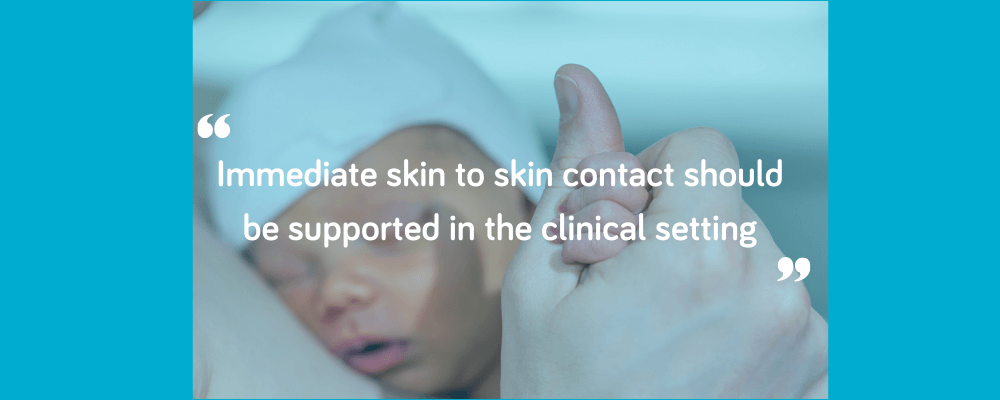A recent publication1, has examined the impact of immediate skin to skin contact (with-in the first six hours) on mother-infant relationship.
Study design
Skin to skin contact (SSC) between either parent and their very preterm infant(s) was initiated immediately after birth in the birth unit (vaginal birth). Babies were then transferred to the neonatal intensive care unit (NICU) and SSC continued through-out the first six hours after birth (SSC group). After caesarean birth it was initiated with fathers, until the mothers could be transferred to the NICU. This was compared with a control group who received conventional care in an incubator cot. A follow-up visit was conducted at 4 months (corrective age). Mother-infant interaction was video recorded and measured with the Parent–Child Early Relational Assessment (PCERA) along with parental mental health assessment questionnaires.
Findings
Findings from the study support the existence of an ‘early sensitive period for very preterm infants after birth’. Infants in the immediate skin-to-skin group demonstrated a significantly higher quality interaction in subscale 3 (infant positive affect, communicative and social skills). Additionally, after adjustment for observation setting, a significant difference was also observed on subscale 5; motional tone, reciprocity and regulation. The study concludes that ‘‘These findings suggest that immediate SSC should be supported in the clinical setting’’. Further studies2,3 on the benefits of immediate skin to skin contact are referenced below.
SurePulse
The SurePulse VS Cap is a heart rate monitor which has been designed to provide clinical teams with accurate, reliable, and timely information in the critical moments after birth. The wireless nature of the SurePulse VS helps to reduce the number of wires on the baby, promoting skin to skin contact immediately after birth in the delivery room. A recent study4 using the SurePulse VS found that ‘Wireless HR monitoring has the potential for assisting safe and effective monitoring by staff, while allowing parents greater autonomy during first cuddles with their babies in the DR.’
References
- Lilliesköld S, Lode-Kolz K, Rettedal S, et al. Skin-to-Skin Contact at Birth for Very Preterm Infants and Mother-Infant Interaction Quality at 4 Months: A Secondary Analysis of the IPISTOSS Randomized Clinical Trial. JAMA Netw Open.2023;6(11):e2344469. doi:10.1001/jamanetworkopen.2023.44469
- Myhill, J., Pocock, L. and Clarke, P. (2023) ‘Feasibility and acceptability of a novel forehead-mounted wireless heart rate monitoring device in preterm babies’, Oral Presentation at the Congress of joint European Neonatal Societies (JENS) 2023.
- Linnér A, Lode Kolz K, Klemming S, Bergman N, Lilliesköld S, Markhus Pike H, Westrup B, Rettedal S, Jonas W. Immediate skin-to-skin contact may have beneficial effects on the cardiorespiratory stabilisation in very preterm infants. Acta Paediatr. 2022 Aug;111(8):1507-1514. doi: 10.1111/apa.16371. Epub 2022 Apr 28. PMID: 35466432.
- WHO Immediate KMC Study Group; Arya S, Naburi H, Kawaza K, Newton S, Anyabolu CH, Bergman N, Rao SPN, Mittal P, Assenga E, Gadama L, Larsen-Reindorf R, Kuti O, Linnér A, Yoshida S, Chopra N, Ngarina M, Msusa AT, Boakye-Yiadom A, Kuti BP, Morgan B, Minckas N, Suri J, Moshiro R, Samuel V, Wireko-Brobby N, Rettedal S, Jaiswal HV, Sankar MJ, Nyanor I, Tiwary H, Anand P, Manu AA, Nagpal K, Ansong D, Saini I, Aggarwal KC, Wadhwa N, Bahl R, Westrup B, Adejuyigbe EA, Plange-Rhule G, Dube Q, Chellani H, Massawe A. Immediate “Kangaroo Mother Care” and Survival of Infants with Low Birth Weight. N Engl J Med. 2021 May 27;384(21):2028-2038. doi: 10.1056/NEJMoa2026486. PMID: 34038632; PMCID: PMC8108485.
